Chemistry Services
Performing investigative testing and analytical services
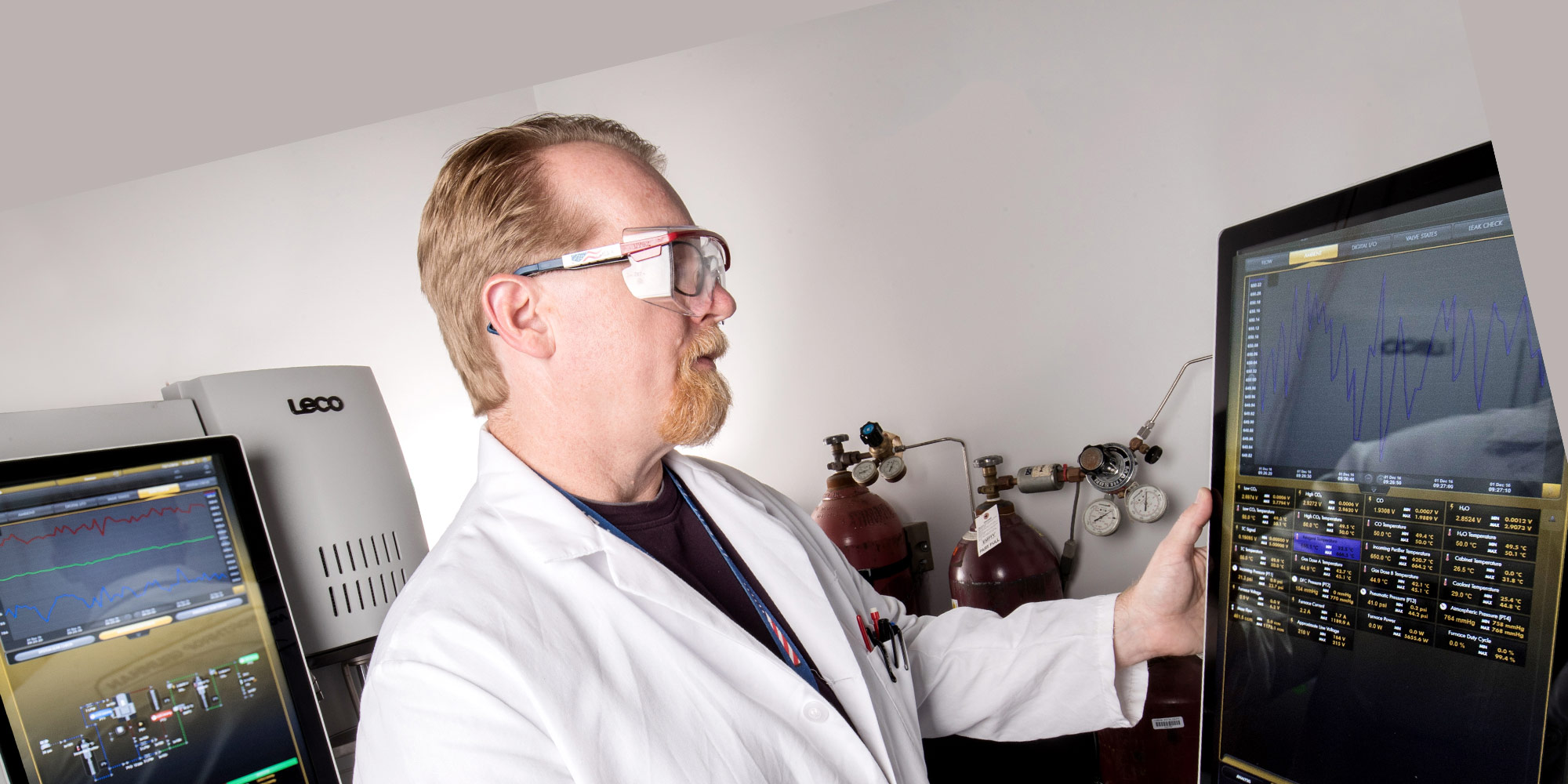
Our Chemistry Services laboratories are equipped with state of the art instruments and staffed by leaders in the fields of chemistry, engineering and science.
We are eager to solve complex chemistry problems.
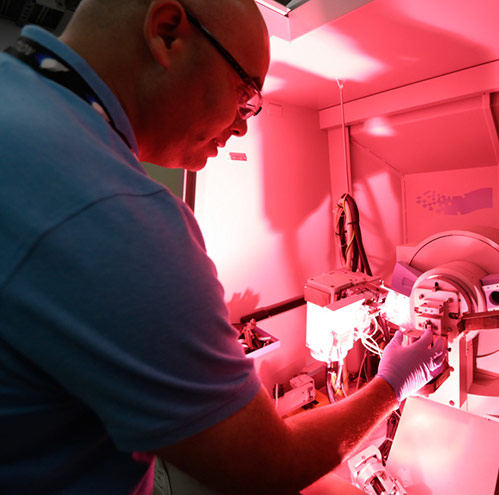
Chemistry Services Capabilities
Our capabilities include:
- Consulting Services
- Failure Analysis
- Materials Characterization
- Contamination Analysis
- Surface Imaging and Elemental Analysis
- Thermomechanical Analysis
- Rapid Prototyping Design/Build/Demonstration
- Hazardous and Explosive Materials Testing/Handling
Facilities and Equipment Available to Perform Analyses
For Instrument Details/Parameters, Click on Headings Below:
Elemental Analysis
- Oxygen/Nitrogen/Hydrogen Elemental Analyzer
- Carbon/Sulfur Elemental Analyzer
- Carbon Analyzer
- Atomic Absorption (AA) With Aspirated and Graphite Furnace Sample Introduction
- Inductively Coupled Mass Spectrometry (ICPMS)
- Inductively Coupled Plasma Optical Emission Spectrometry (ICPOES)
- X-ray Fluorescence Spectrometer (XRF)
- Electrogravimetric Analyzer
Molecular Analysis
- ThermoFisher Scientific Ulta High Presure Liquid Chromatograph (UPLC) with LTQ XL™ Linear Ion Trap Mass Spectrometer (MS)
- Moisture Meter
- Moisture Meter With Solid Probe
- X-Ray Diffraction (XRD)
- Fourier Transform Infrared Spectrometer (FTIR)
- High Performance Liquid Chromatography (HPLC)
- Gas Chromatography (GC) With Gas Introduction Capabilities #1
- Gas Chromatography (GC) With Gas Introduction Capabilities #2
- Gas Chromatography / Mass Spectrometry (GCMS) With Head Space Analyzer
- Ion Chromatography (IC)
- Ultraviolet and Visible Spectrometer (UV/VIS)
- Gas Analyzer
Physical Analysis
- Brookfield Rheometer
- ARES Rheometer
- Conductivity Meter
- Refractometer
- Tensiometer
- Fluorometer
- Zetasizer Particle Size Analyzer
Surface Analysis
- Auger / Electron Spectrometry for Chemical Analysis (ESCA, XPS)
- Profilometer
- Scanning Electron Microscope with Elemental Determination Capabilities
Thermal Analysis
- Thermal Mechanical Analyzer (TMA)
- Dynamic Mechanical Analyzer (DMA)
- Simultaneous Differential Temperature Analysis and Thermal Gravimetric Analysis (SDT:DTA/TGA)
- Differential Scanning Calorimeter (DSC)
Other
- Microwave Sample Digester
- Laminar Flow Bench
- Optical Microscope with Image Capture
- Balances
- Glove Box
- Rotovap
- Centrifuge
- Ovens
- DI Water System
- Casio EXLIM EX-F1 High Speed Camera
| Leco ONH836 Elemental Analyzer | |
|---|---|
| Description | Applications |
| Leco ONH836 Elemental Analyzer | Quantitative determination of oxygen, nitrogen, and hydrogen of inorganic materials, ferrous and nonferrous alloys, and refractory materials using the inert gas fusion technique. |
| Specifications | |
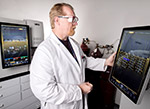 Instrument Range (1 g sample) Instrument Range (1 g sample)
|
|
| Atomic Absorption (AA) With Aspirated and Graphite Furnace Sample Introduction | |
|---|---|
| Description | Applications |
|
|
| Specifications | |

|
|
| Carbon Analyzer | |
|---|---|
| Description | Applications |
| Shimadzu TOC-V CSH/ASI-V | Quantitative determination of total organic carbon (TOC) and total inorganic carbon (TIC) |
| Specifications | |
 Sample Type: Sample Type:
|
|
| Inductively Coupled Plasma Optical Emission Spectrometry (ICP-OES) | |
|---|---|
| Description | Applications |
| Spectro Ciros Vision simultaneous measurement optical emission spectrometer. |
|
| Specifications | |
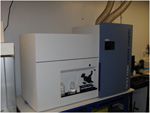 Uses inductively coupled plasma to generate excited atoms which emit element-specific radiation. This radiation is diffracted into its spectral components in the optical system. A diode array of semiconductor detectors (CCDs) provides simultaneous measurement of emission intensities, which are in turn converted into element concentrations by the Ciros Vision's dedicated Smart Analyzer software. Uses inductively coupled plasma to generate excited atoms which emit element-specific radiation. This radiation is diffracted into its spectral components in the optical system. A diode array of semiconductor detectors (CCDs) provides simultaneous measurement of emission intensities, which are in turn converted into element concentrations by the Ciros Vision's dedicated Smart Analyzer software. |
|
| Electrogravimetric Analyzer | |
|---|---|
| Description | Applications |
| Eberbach electrodeposition machine. |
|
| Specifications | |
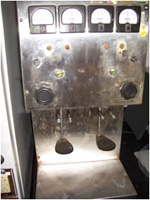
|
|
| Inductively Coupled Mass Spectrometry (ICP-MS) | |
|---|---|
| Description | Applications |
| Perkin Elmer ELAN 6100 Inductively Coupled Plasma Mass Spectrometer (ICP-MS) |
|
| Specifications | |
 Argon plasma torch operates at 6000 K to generate population of singly-charged atoms which are passed through sampling and skimming cones into a 10-5 torr vacuum chamber. Ions are passed through a voltage-controlled ion lens into a quadrapole mass spectrometer that continually rasters across the entire elemental mass range. The ions are detected by a dual-range ETP detector having sensitivity from a few counts/sec to millions of counts/sec, allowing a dynamic range that extends from ppt to ppm. The TotalQuant Application allows for rapid semi-quantitation of most elements in the periodic table and automatically corrects for spectral interferences. The Quantitative Analysis application allows for rapid simultaneous quantitation of selected elements. Argon plasma torch operates at 6000 K to generate population of singly-charged atoms which are passed through sampling and skimming cones into a 10-5 torr vacuum chamber. Ions are passed through a voltage-controlled ion lens into a quadrapole mass spectrometer that continually rasters across the entire elemental mass range. The ions are detected by a dual-range ETP detector having sensitivity from a few counts/sec to millions of counts/sec, allowing a dynamic range that extends from ppt to ppm. The TotalQuant Application allows for rapid semi-quantitation of most elements in the periodic table and automatically corrects for spectral interferences. The Quantitative Analysis application allows for rapid simultaneous quantitation of selected elements. |
|
| X-ray Fluorescence Spectrometer (XRF) | |
|---|---|
| Description | Applications |
|
|
| Specifications | |
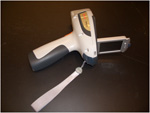 Sample Type: Sample Type:
|
|
Molecular Analysis
| Moisture Meter | |
|---|---|
| Description | Applications |
| Mitsubishi MCI CA-21 uses Coulometric Karl Fischer titration to determine the water content of solutions. | Can be used to determine the water content of solvents. |
| Specifications | |
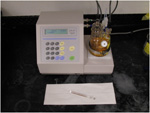
|
|
| Moisture Meter With Solid Probe | |
|---|---|
| Description | Applications |
| Mitsubishi MCI CA-05 uses Coulometric Karl Fischer titration to determine the water content of solutions. It also has the capability to measure the water content of solids using the purged oven. | Can be used to determine the water content of solvents, solids and gases. |
| Specifications | |
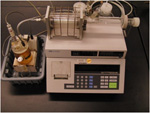
|
|
| X-Ray Diffraction (XRD) | |
|---|---|
| Description | Applications |
|
|
| Specifications | |
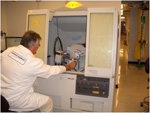
|
|
| Fourier Transform Infrared Spectrometer (FTIR) | |
|---|---|
| Description | Applications |
Thermo Scientific Nicolet 6700/Nicolet Continuum microscope analyzes materials providing an infrared spectrum, which is indicative of the material identification and quantity. Attachments include: Angular Spectular Reflectance, Attenuated Total Reflectance, Diffuse Reflectance , Grazing Angle Reflectance. 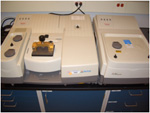 |
|
| Specifications | |
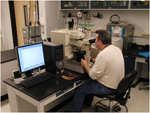 Spectral Ranges: Spectral Ranges:
|
|
| High Performance Liquid Chromatography (HPLC) | |
|---|---|
| Description | Applications |
| Shimadzu LC-20AT/CTO020A/SPD-20A/RID-10A | Identify, quantify, and/or purify the individual components of a mixture. |
| Specifications | |
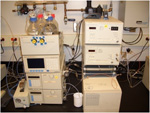
|
|
| Gas Chromatography (GC) With PID | |
|---|---|
| Description | Applications |
|
|
| Specifications | |

|
|
| Gas Chromatography (GC) With PID | |
|---|---|
| Description | |
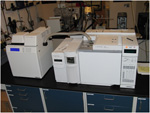 HP 6890N GC and G1888 Head Space Analyzer HP 6890N GC and G1888 Head Space Analyzer |
| Gas Chromatography (GC) With FID and TCD | |
|---|---|
| Description | Applications |
|
Fixed Gas Analysis (H2, H2, N2, O2, CO, CO2, NH3, Ar, Ne, Kr, Xe...) |
| Specifications | |
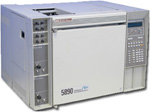
|
|
| ThermoFisher Scientific Ulta High Presure Liquid Chromatograph (UPLC) with LTQ XL™ Linear Ion Trap Mass Spectrometer (MS) | |
|---|---|
| Description | Applications |
| ThermoFisher Scientific Ultra High Pressure Liquid Chromatograph (UPLC) with LTQ XL™ Linear Ion Trap Mass Spectrometer (MS), with Electrospray (ESI), Atmospheric Pressure Chemical Ionization (APCI), Laser Diode Thermal Desorption (LDTD) and Direct Analysis in Real Time (DART) sources. | Qualitative and quantitative analysis of complex non-volatile mixtures of organic materials. |
| Specifications | |
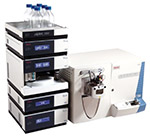
|
|
| Ion Chromatography (IC) | |
|---|---|
| Description | Applications |
|
|
| Specifications | |
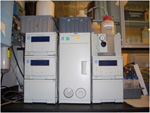
|
|
| UV/VIS/NIR Spectrophotometer with Diffuse Reflectance | |
|---|---|
| Description | Applications |
| Cary 5000 UV/VIS/NIR Varian External Diffuse Reflectance Accessory | The Cary 5000 is a high performance UV-Vis-NIR spectrophotometer with superb photometric performance in the 175-3300 nm range. The PbSmart detector makes it a powerful tool for analytical chemistry and materials science research. The large sample compartment can be expanded to hold large accessories and integrating spheres for spectral and diffuse reflectance. The LockDown mechanism makes it possible to quickly change and position accessories for reproducible results. |
| Specifications | |
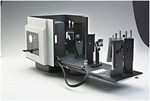
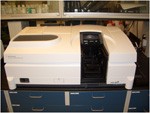
|
|
| High Sensitivity Gas Analyzer | |
|---|---|
| Description | Applications |
| Teledyne Analytical instrument measures oxygen, water and hydrocarbon contents in gas streams | Unit is portable |
| Specifications | |
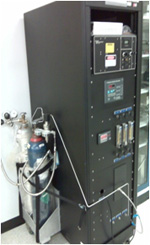 Gas Gas
|
|
| Portable Gas Analyzer | |
|---|---|
| Description | Applications |
| Teledyne Analytical instrument measures oxygen and water contents in gas streams | Unit is portable |
| Specifications | |
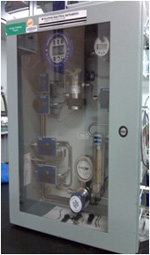 Gas Gas
|
|
Physical Analysis
| Brookfield Rheometer | |
|---|---|
| Description | Applications |
| The Brookfield Rheometer measures the viscosity of viscous solutions at various flow conditions or shear rates. The instrument measures the torque required to rotate a specific spindle through a liquid. Using the different RPM to rotate the spindle allows measurements at various shear rates. A rheometer is different from a viscometer in that the viscometer can only measure viscosity at a single flow condition. |
|
| Specifications | |

|
|
| ARES Rheometer | |
|---|---|
| Description | Applications |
| Rheometric Scientific ARES rheometer is a true strain controlled unit having the measuring transducer separated from the drive motor. This unit is versatile and can be operated in steady or dynamic modes. The Tool has fixtures for cone and plate, parallel plate, rectangular torsion for solids, and extensional viscosity fixture for polymeric films. The unit is fitted with liquid nitrogen cooling giving an effective test temperature of -150 to 600°C | The rheometer can be used for the study of polymeric melts, flow characteristics, gel time, and much more. Dynamic Mechanical Analysis of Polymer Blends. Influence of Internal Strains on Injection Molding. |
| Specifications | |

|
|
| Conductivity Meter | |
|---|---|
| Description | Applications |
| Determines water purity using a conductivity probe |
|
| Specifications | |

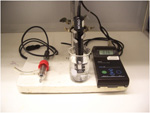
|
|
| Refractometer | |
|---|---|
| Description | Applications |
| Thermo – ABBE-3L Refractometer |
|
| Specifications | |
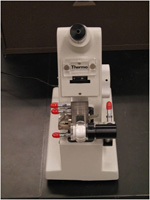
|
|
| Fluorometer | |
|---|---|
| Description | Applications |
| Thermo Scientific Filter The Wide Band Model offers both flexibility and value for studies that require UV excitation and full-range emission detection. The fluorometer features both a quartz halogen and a mercury lamp to create an excitation range spanning 254 to 750 nm. A red sensitive PMT measures emission from 190 to 870 nm. This model is well suited for laboratories performing assays in the UV or near-infrared. | Measurements using fluorescence. Can be interfaced to HPLC. Measure fluorescein concentrations down to 20 ppt |
| Specifications | |
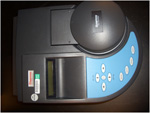
|
|
| Tensiometer | |
|---|---|
| Description | Applications |
| Precise torsion balance for measuring surface tension of liquids |
|
| Specifications | |
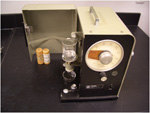
|
|
| Zetasizer Particle Size Analyzer | |
|---|---|
| Description | Applications |
| The Malvern Zetasizer series measures particle and molecule size from below a nanometer to several microns using dynamic light scattering, zeta potential and electrophoretic mobility using electrophoretic light scattering, and molecular weight using static light scattering. | Determining the molecular or particle size of species suspended in liquids. |
| Specifications | |
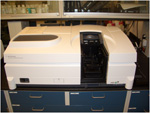 Particle and molecule sizes from below a nanometer to several microns Temperature range (°C): 0 - 90 Particle and molecule sizes from below a nanometer to several microns Temperature range (°C): 0 - 90 |
|
Surface Analysis
| Auger / Electron Spectrometry for Chemical Analysis (ESCA) | |
|---|---|
| Description | Applications |
| The VG ESCALAB 250 has XPS and Auger capabilities. XPS capability allows for the elemental identification and binding energy determination. Binding energy provides information on the chemical state of the element. Auger capability allows for elemental identification and limited binding energy. XPS uses an X-ray beam to probe the sample surface, so has a spatial resolution of on about 10 mm. Auger uses an electron beam to probe the surface, so has a spatial resolution of 10nm. The system has an argon ion beam which can be used to clean a surface for analysis or create depth profiles. | The ESCALAB can be used as an XPS to quantify elemental surface concentrations and provide binding energy, which can be translated to provide chemical information. The ESCALAB can also be used as an Auger to provide elemental surface concentrations with very small spot size. In both cases the depth of analysis is about 100 Angstroms, compared to several microns for SEM analysis. The ESCALAB has been used to examine semiconductor materials, propulsion hardware, adhesive failures and vapor deposited metal layers. |
| Specifications | |
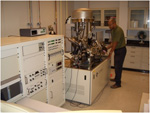
|
|
| Profilometer | |
|---|---|
| Description | Applications |
| The Dektak 3 is a surface texture measuring system, which can analyze the vertical surface profile of the sample: its roughness, waviness and step height. Measurements are made electromechanically by moving the sample beneath a diamond-tipped stylus. Dektak 3 provides accurate height measurements with vertical resolution of 5 Å in a long lateral scan range of 50 μm to 30 mm. The instrument combines a reliable measurement accuracy of 10 Å, 1σ step height repeatability, enabling precise measurements of thin films below 100 Å. A color video camera and provides both the real time viewing of the scan in progress and saves a video image of the analyzed surface for further reference. |
|
| Specifications | |
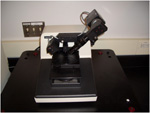
|
|
| Scanning Electron Microscope with EDX and WDX | |
|---|---|
| Description | Applications |
| JEOL JSM-5900 Scanning Electron Microscope (SEM) produces images of a sample by scanning it with a focused beam of electrons. The electrons interact with atoms in the sample, producing various signals that can be detected and that contain information about the sample's surface topography and composition. SEM can achieve resolution better than 1 nanometer. Elemental analysis can be achieved using EDAX-EDX or Oxford Microspec WDX methods. | Produces high resolution images with large depth of field. Image capabilities include: Secondary Electron, Back-Scattered Electrons and X-Ray Elemental Dot Mapping. Large sample chamber accommodates samples as large as 12 inches. Used for failure analysis, metal analysis, elemental analysis and other image and elemental disciplines. |
| Specifications | |
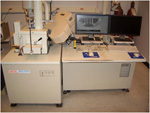
|
|
Thermal Analysis
| Thermal Mechanical Analyzer (TMA) | |
|---|---|
| Description | Applications |
| TA Instrument's TMA 2960 measures a change of a dimension or a mechanical property of the sample while it is subjected to a temperature regime. The platform and probe are made of quartz. Since the temperature is computer controlled, the temperature regime can be a ramp, step functions or oscillation. |
|
| Specifications | |
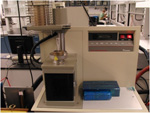
|
|
| Dynamic Mechanical Analyzer (DMA) | |
|---|---|
| Description | Applications |
| TA Instrument's 2980 measures the visco-elastic nature of polymers by applying an oscillating force to a sample and measuring the resulting displacement of the sample. The sample deforms under the load. From this the stiffness of the sample can be determined, and the sample modulus can be calculated. By measuring the time lag in the displacement compared to the applied force it is possible to determine the damping properties of the material. The time lag is reported as a phase lag, which is an angle. The damping is called tan delta, as it is reported as the tangent of the phase lag. | The DMA is used to measure viscoelastic properties such as modulus, tan delta, glass transition, beta and gamma transition. |
| Specifications | |
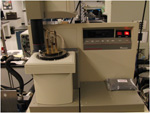
|
|
| Simultaneous Differential Temperature Analysis and Thermal Gravimetric Analysis (SDT:DTA/TGA) | |
|---|---|
| Description | Applications |
| TA Instrument's 2960 measures the mass change and heat flow from a sample in a controlled gaseous environment. | The SDT is used to measure the mass loss and heat flow from a sample. TGA is commonly employed in research and testing to determine characteristics of materials such as polymers to determine degradation temperatures, absorbed moisture content of materials, the level of inorganic and organic components in materials, decomposition points of propellants, and solvent residues. It is also often used to estimate the corrosion kinetics. |
| Specifications | |
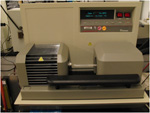
|
|
| Differential Scanning Calorimeter (DSC) | |
|---|---|
| Description | Applications |
| TA Instrument's 2910 measures the difference in the amount of heat required to increase the temperature of a sample and reference are measured as a function of temperature. Both the sample and reference are maintained at nearly the same temperature throughout the experiment. Generally, the temperature program for a DSC analysis is designed such that the sample holder temperature increases linearly as a function of time. The reference sample should have a well-defined heat capacity over the range of temperatures to be scanned. | The DSC can be used to identify the temperature for thermal changes in a sample, such as glass transition, melting point, and phase changes. It can also be used to measure the heat flow phenomena, such as exothermic and endothermic reactions. The residual cure for epoxies can be seen using DSC. |
| Specifications | |
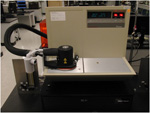
|
|
Other
| Microwave Digestion Oven | |
|---|---|
| Description | Applications |
| CEM MARS 5 Microwave Digestion System |
|
| Specifications | |
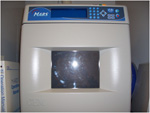
|
|
| Laminar Flow Bench | |
|---|---|
| Description | Applications |
| The Chemistry laboratory department has two laminar flow benches for working in a low particle clean environment. Both are Class 10,000 hoods and the flow and particle count are checked once per month. |
|
| Specifications | |
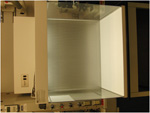
|
|
| Balances | |
|---|---|
| Description | Applications |
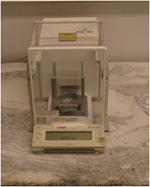 Balances Balances |
Analytical balances obtain an accurate mass to a very high degree of precision and accuracy. Min range = 2micrograms; Max range = 3000grams (6.6pounds) |
| Specifications | |
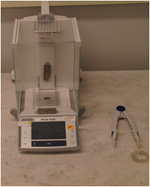 Balance Max (grams) Precision (mg) Balance Max (grams) Precision (mg)
|
|
| Optical Microscope | |
|---|---|
| Description | Applications |
| Leica M2-16 Binocular microscope with color camera. | Used to visualize small items. Large working distance allows for performing work under the microscope. High resolution camera allows for photo-documentation of samples. |
| Specifications | |
 Magnifications: Magnifications:
|
|
| Glove Box | |
|---|---|
| Description | Applications |
| Balances | Provides a low moisture and oxygen environment for samples |
| Specifications | |
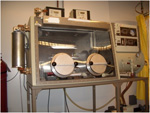 Samples must have a low moisture and oxygen content. Samples must have a low moisture and oxygen content. |
|
| Centrifuge | |
|---|---|
| Description | Applications |
| The Beckman Coulter Allegra X-22 centrifuge uses centrifugal force to separate mixtures of materials that have different densities. |
|
| Specifications | |
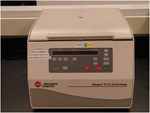
|
|
| Rotary Evaporator | |
|---|---|
| Description | Applications |
| BUCHI Rotavapor R-200 Rotary Evaporator |
|
| Specifications | |
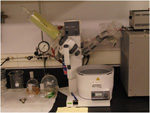
|
|
| Ovens | |
|---|---|
| Description | Applications |
| Lab Ovens | Heating processes |
| Specifications | |
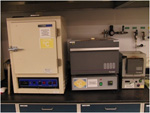
|
|
| DI Water System | |
|---|---|
| Description | Applications |
| Sophisticated high-purity deionized (DI) water feed system that processes DI water from building deionizing beds into a pump-driven polishing loop with dedicated UV lamp. This is fed to two Millipore Milli-Q Element ultrahigh-purity water systems resulting in DI water that is essentially free of all inorganic and organic impurities. |
|
| Specifications | |

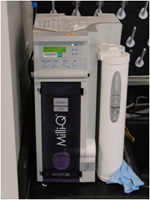
|
|
| Casio EXLIM EX-F1 High Speed Camera | |
|---|---|
| Description | Applications |
| The EXLIM can operate as a single shoot or high speed digital camera. The shooting rate is variable for the 60 images, ranging from one image per second for a full minute (one image per second) to 60 fps. All of this means that the EX-F1 allows burst shooting at speeds faster than those possible with a single reflex camera, and beautiful images of each moment of high-speed action as it occurs. |
|
| Specifications | |
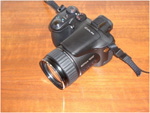
|
|
Becoming a Customer
Aerospace Services makes it easy to do business with the individual service units, using efficient quoting, contracting, and invoicing processes. Aerospace Services has provided high quality service to many satisfied customers and is committed to delivering a positive customer experience. To get started, contact a specialist to request information on Testing and Engineering services or request a quotation if you already know what you need. Also see the FAQs for more information.
Contact Us
E-mail: Chemistry Services
Phone: 310-813-0000